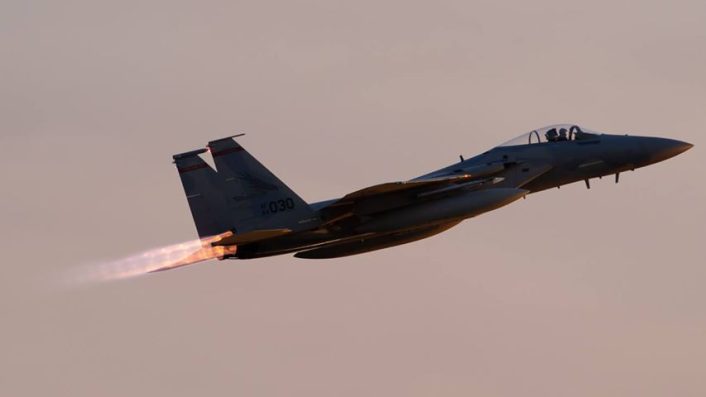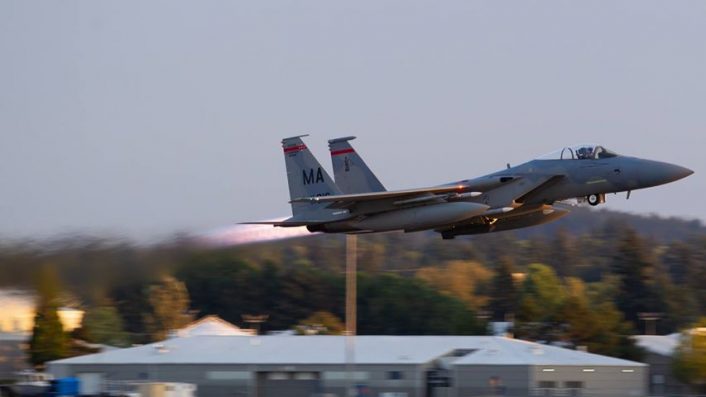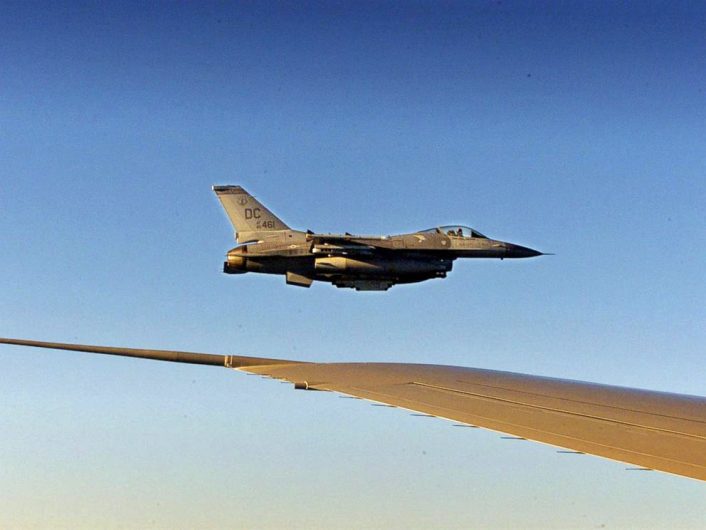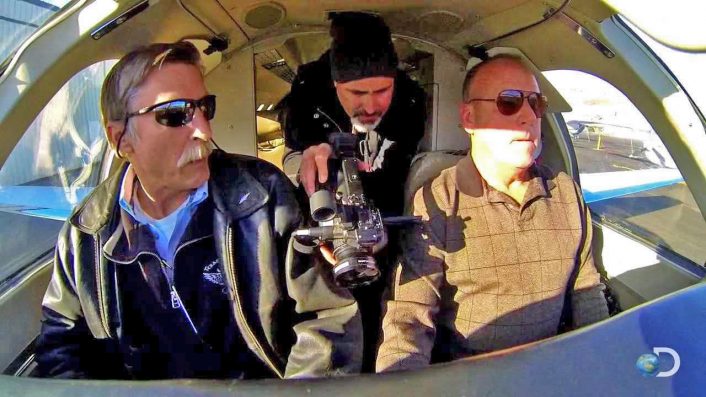Questions Remain in Stolen Airliner Crash: How Could It Happen? What is The Response?
Nearly 17 years after the 9/11 terror attacks the bizarre stolen aircraft, intercept and crash incident in Washington state on Friday raises serious concerns not only about airline safety but about national security.
How could a person – who is not a pilot- simply take a civilian airliner parked on the ground, get it into the air and create a serious national security risk? What does the Air Force do in an incident like this? And most urgently, after nearly two decades of taking our shoes off at TSA security checks, how could this have ever happened?
As information about the aircraft theft and crash in Washington continues to emerge there remain more questions than answers. In the wake of Friday’s incident TheAviationist.com spoke to two sources inside the airline service/security industry and the U.S. military about the incident and the security countermeasures to prevent incidents like this. We also asked about the U.S. military response to stolen/hijacked aircraft once they get in the air and their level of readiness to respond with lethal force to such an incident. Because both sources we spoke to continue to work in these fields and for the U.S. military they agreed to speak to us only on condition of anonymity.
In late 2016, this reporter visited a flight service provider at Detroit’s Metropolitan Wayne County Airport (DTW). We were given a tour of flight line services provided to airline aircraft that included maintenance and aircraft interior cleaning, sanitation servicing (pumping out aircraft toilets after flights), ground traffic control and most significantly, security.

During our visit to Detroit’s Metro Airport we were notified in advance to park off the airport grounds in an outer lot and use an employee shuttle to enter the flight line service facility. We were required to provide both photo ID and clearance from an authorized person to board the bus used by employees to reach the flight line service provider’s building. Inside the facility, we were required to wear a “guest” ID tab and be escorted by a security badge holder at all times, including restroom visits. Each entry door we used to move from passenger spaces within the airport terminal to the service spaces required a card swipe and/or a security code. Each of these entries is logged in a central security system. Once past the security screen the area was full of employees performing everything from updating a massive spreadsheet that contained all aircraft movement in the airport to ground traffic control. Employees also moved massive volumes of prepared meals to airliners for passengers in flight. Trash was emptied from airliners and trucked off lift vehicles you see from the boarding gates. Chemical toilets on airliners were pumped out and cleaned.
As an ongoing part of security protocols and readiness testing the Transportation Security Administration was conducting unannounced tests of aircraft cleaners and their managers. The TSA would conceal false explosive devices on an airliner prior to cleaning and then covertly observe if the simulated bombs were detected by cleaning crews. In an alarming outcome, our source revealed that there had been numerous failures on the part of contracted aircraft maintenance and cleaning services to locate these simulated bombs. As a result, the contracted service provider at the airport was put on official notice of corrective action. Immediately following our inspection and orientation of the facility and the service provider, several upper level management terminations occurred as a direct result of the failures of these tests in 2016. One upper level employee, our contact, left the airline service industry for a position in financial security following the security test failures in 2016 at DTW.
Based on our examination of airport service provider security protocols, while there were substantial security measures in place including background checks and drug tests for employees, security badges and secure entryways that required a coded entry, all under video surveillance, there were still security breaches among the airport service providers on a fairly regular basis. The TSA maintained a database of the security tests and put the contracted service providers on notice when they failed security tests. This resulted in high employee turnover.
But what happens once the systems on the ground fail and an aircraft is able to get into an airspace without authorization?
We spoke to a former U.S. Air Force F-16 pilot and combat veteran who stood the domestic airspace alert mission in the United States. Because of continuing affiliation with the U.S. armed forces, he agreed to speak to us on condition of anonymity.

We asked our source within the armed forces if fighter aircraft responding to alert intercept calls carry live weapons:
“Aircraft are loaded with live AIM-9M and AIM-120B/C weapons. [There is a] full load of 20-millimeter cannon as well. There are thresholds for launching aircraft based on the unidentified tracks crossing borders or certain types of distress calls including hijacking or stolen airplanes. Likely the aircraft were launched with very little knowledge, potentially only that an uncleared aircraft took off. NORAD orders alert launches. Authorization to release an aircraft like that is typically in order to save lives or stop an attack once other attempts to communicate with the aircraft have failed. If that aircraft is turned toward a population center it would likely have been engaged. That engagement call comes from NORAD, at the O-7 (Brigadier General) level.”
Our source went to say, “It was a fun mission to take off in an instant and blitz across the desert supersonic at god-knows-what. But the responsibilities of what we may have to do was very heavy.”

On February 16, 2017, just such an intercept occurred over European airspace. A Jet Airways Boeing 777-300 with registration VT-JEX operating as flight 9W-118 from Mumbai, India to London’s Heathrow airport was underway at 36,000 feet (FL360) about 20 miles north of Cologne, Germany when the aircraft lost radio communication with controllers. It was intercepted by two German Luftwaffe Eurofighter Typhoons aircraft due to loss of communication.
Following the 2017 incident, a Jet Airways spokesperson told media in a release: “Contact between Jet Airways flight 9W 118, from Mumbai to London Heathrow, of February 16, 2017, and the local ATC, was briefly lost while flying over German airspace. Communication was safely restored within a few minutes. As a precaution, the German Air Force deployed its aircraft to ensure the safety of the flight and its guests.” Airline officials went on to report that, “The flight with 330 guests and 15 crew subsequently landed at London without incident.”
Similar episodes occur quite frequently in the skies all around the world. In Italy, for instance, there were as many as 8 scrambles of the Italian Air Force QRA (Quick Reaction Alert) Eurofighter Typhoons, due to loss of communication by civilian/general aviation aicraft since the beginning of July alone!
8th Alert Scramble by @ItalianAirForce QRA to intercept a civil/GA aircraft suffering loss of radio contact since the beginning of July. Good training opportunity or waste of resources? https://t.co/vsbixkyHpg
— David Cenciotti (@cencio4) August 9, 2018
In another recent incident related to military aircraft flying armed security patrol missions a Spanish Air Force Eurofighter Typhoon combat aircraft accidentally fired (at least according to the details emerged so far – it’s not clear whether it “just” released) an AIM-120 Advanced Medium Range Air-to-Air Missile (AMRAAM) while flying near Otepää in Estonia, less than 50 km west of the Russian border.
In the case of Friday’s theft of an empty 76-seat, twin-engine turboprop Bombardier Q400, belonging to Alaska Airlines’ sister carrier Horizon Air, the aircraft may not have flown near population centers long enough to present a risk that required armed intervention from responding F-15s. Additionally, the person who took the Alaska Airlines Q400 was in communication with controllers and appeared to not openly demonstrate a terrorist agenda. Had they done so, it is possible the outcome of the incident may have included the Q400 being engaged by the responding F-15s.
The threat posed by aircraft being stolen from airports is clearly significant as evidenced by Friday’s incident. Perhaps a greater risk comes from general aviation aircraft and not large commercial aircraft. These aircraft are easy to access and bit easier to operate. Even the commercial, twin-engine turboprop Bombardier Q400 stolen on Friday could be flown by a “pilot” who, based on reports, had only practiced operating the aircraft on a home computer flight simulator. Similar home computer simulators were known to have been used by the 9/11 attackers according to the 9/11 Commission Report issued in July, 2004.
As of 2009, the CIA reported that there were approximately 44,000 “… airports or airfields recognizable from the air” around the world, including 15,095 in the US. Of these flight facilities, there are 5,194 with paved runways. The U.S. has about a third of all airports, and the most of any single country. According to the Airplane Owner’s and Pilot’s Association (AOPA) there are approximately 20,000 airfields in the U.S. without a control tower and only about 500 airports with control towers. Airfields without a control tower are still subject to air traffic control, but from a facility usually located away from the airfield.
In 2010, the Discovery Channel began airing a television reality show called “Airplane Repo” produced by Undertow Films. The show features often reenacted and dramatized stories about aircraft and boats that are being repossessed from debtors by a cast of specialty pilots and private recovery persons who “steal” the airplanes back for banks, creditors and private individuals. Aircraft shown in the series are frequently commandeered without authorization or clearance and flown out of small general aviation airports. In one episode, a helicopter was repossessed by being flown off the rooftop of a high-rise building. Another featured an aircraft repossessed in Mexico and being flown without clearance back into the United States. The producers claim the show depicts actual events that are often re-staged by actors for the series. A key takeaway from the documentary series, that ran on the Discovery Channel for three full seasons until 2015, and from Friday’s incident in Washington state, is that aircraft in the United States are not as secure as they perhaps should be.

Top image: Rock 42 scrambles from Portland to intercept the stolen Q400 on Aug. 10, 2018 (Credit: Bill Shemley)









